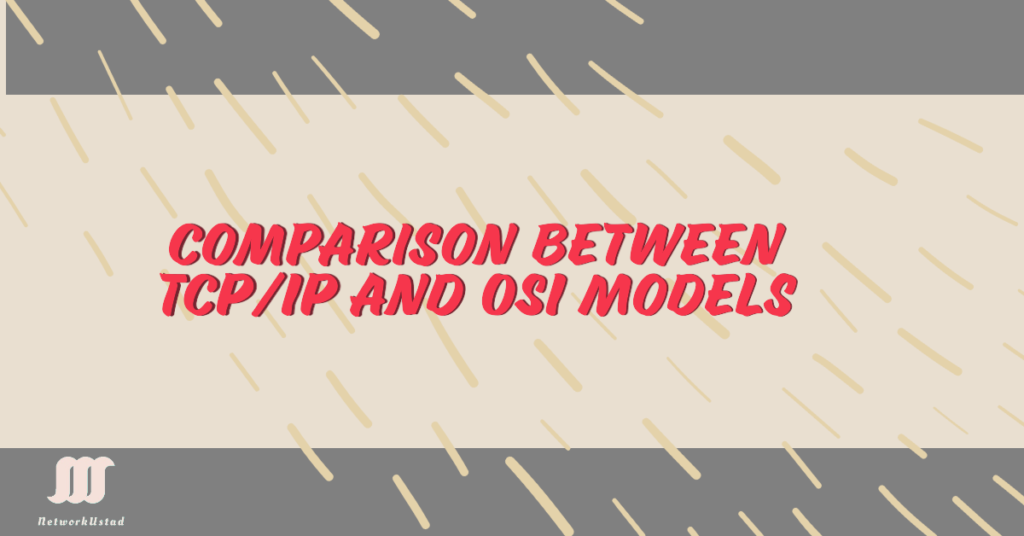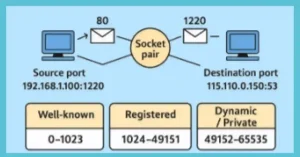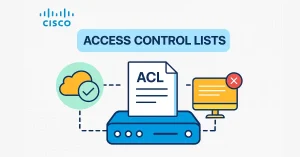Comparison between TCP/IP and OSI models is critical because protocols that make up the TCP IP protocol suite can also be described in terms of the OSI reference model. The network access layer and application layer of the TCP IP models are further divided, and the OSI model describes discrete functions that must occur at these layers. Both models are widely used networking models for communication. The critical difference between the two is that OSI is a conceptual model that is not practically used for communication. In contrast, TCP IP establishes a connection and communicates through the network.
The network Access layer of the TCP/IP model does not specify which protocols to use when transmitting over a physical medium. It only describes the handover from the Internet layer to the physical layer. On the other hand, the OSI Layer physical and data link layers discuss the basic process of accessing the media and the physical means of sending data over a network.
Network Layer of OSI and Internet Layer of TCP/IP Model
The network layer maps directly to the TCP/IP Internet layer. This layer explains protocols that address and route messages from end to end an internetwork.
Transport Layer
The transport layer maps directly to the TCP IP Transport layer. This layer explains the general services and functions that ensure the ordered and reliable delivery of data between source and destination hosts.
TCP/IP Application Layer
The application layer of the TCP IP model includes several protocols that give specific functionality to various end-user applications. The OSI Model Layers 5, 6, and 7 used as references for application software developers and vendors to produce products that operate on networks.
Comparison between TCP/IP and OSI Models Protocols
Both the TCP IP and OSI models commonly used when referring to protocols at various layers. OSI is a generic, protocol-independent standard, acting as a communication gateway between the network and end user. TCP/IP model is based on standard protocols around which the Internet has developed. It is a communication protocol, which allows connection of hosts over a network. OSI is a reference model around which the networks built. Generally, it is a guidance tool.TCP IP model is, in a way implementation of the OSI model.
| TCP/IP Layers | OSI Layers | Key Responsibility | Common Protocols |
| Application Layer | Application Layer | User Application Services | DNS, NFS, BOOTP, DHCP, SNMP, RMON, FTP, TFTP, SMTP, POP3, IMAP, NNTP, HTTP, Telnet |
| Presentation Layer | Data Translation, Compression and Encryption | SSL, Shells and Redirectors, MIME | |
| Session Layer | Session Establishment, Management and Termination | NetBIOS, Sockets, Named Pipes, RPC |
| Transport Layer | Transport Layer | Process-Level Addressing, Multiplexing/ De-Multiplexing, Connections, Segmentation and Reassembly, Acknowledgments and Retransmissions, Flow Control | TCP and UDP, SPX, NetBEUI/NBF |
| Internet Layer | Network Layer | Logical Addressing, Routing, Datagram Encapsulation, Fragmentation and Reassembly, Error Handling and Diagnostics | IP, IPv6, IP NAT, IPsec, Mobile IP, ICMP, IPX, DLC, PLP, Routing protocols such as RIP and BGP |
| Network Access Layer | Datalink Layer | Logical Link Control, Media Access Control, Data Framing, Addressing, Error Detection and Handling, Defining Requirements of Physical Layer | IEEE 802.2 LLC, Ethernet Family, Token Ring, FDDI and CDDI, IEEE 802.11 (WLAN, Wi-Fi), HomePNA, HomeRF, ATM, SLIP and PPP |
| Physical Layer | Encoding and Signaling, Physical Data Transmission, Hardware Specifications, Topology and Design | Physical layers of most of the technologies listed for the data link layer |
OSI has 7 layers and TCP has 4 Layer model. following is the comparison model of both layer.
Key Differences between TCP/IP and OSI Model
| Feature | TCP/IP Model | OSI Model |
|---|---|---|
| Layers | 4 layers | 7 layers |
| Design Philosophy | Top-down (practical) | Bottom-up (theoretical) |
| Real-World Use | Internet standard | Conceptual framework |
| Protocol Dependency | Protocol-specific (IP, TCP) | Protocol-agnostic |
| Tangibility | Implemented in practice | Abstract reference tool |
Critical Distinctions
Purpose:
- TCP/IP is a protocol suite used globally for internet communication.
- OSI is a theoretical model for standardizing network functions.
Layer Architecture:
- TCP/IP combines OSI’s Layers 5–7 into a single Application layer.
- OSI explicitly separates services (e.g., Session vs. Presentation layers).
Adoption:
- TCP/IP dominates modern networks due to its simplicity and scalability.
- OSI guides protocol design but is rarely implemented in full.
Approach:
- TCP/IP follows a client-server architecture.
- OSI emphasizes modularity for interoperability.
Practical Implications
- Developers: Use OSI to design cross-compatible software (e.g., VPNs leveraging Layer 3).
- Network Engineers: Rely on TCP/IP for configuring routers, firewalls, and servers.
- Troubleshooting: OSI’s layered structure helps isolate issues (e.g., physical vs. application-layer faults).
Conclusion – Comparison between TCP/IP and OSI Models
While the OSI model provides a comprehensive framework for understanding networks, TCP/IP is the backbone of modern connectivity. Their comparison underscores the importance of balancing theoretical concepts (OSI) with real-world implementation (TCP/IP). For deeper insights, explore:
FAQs
What is the main difference between the TCP/IP and OSI models?
The TCP/IP model is a practical, protocol-oriented standard with four layers, developed earlier for internet use. The OSI model is a theoretical framework with seven layers, designed by ISO for standardized network communication. TCP/IP combines some OSI layers, like the application, presentation, and session layers, into one.
How do the layers of the TCP/IP model correspond to the OSI model?
The TCP/IP application layer covers OSI’s application, presentation, and session layers. The TCP/IP transport and internet layers align with OSI’s transport and network layers, respectively. The TCP/IP network interface layer combines OSI’s data link and physical layers.
Why does the OSI model have more layers than the TCP/IP model?
The OSI model’s seven layers provide a detailed, theoretical breakdown of network functions for interoperability across systems. TCP/IP, designed for practical internet use, simplifies this into four layers. This reduces complexity but merges some functions, like session management, into the application layer.
What are the similarities between the TCP/IP and OSI models?
Both models use a layered architecture to structure network communication. They share similar transport and network layer functions and break data into packets for transmission. Each model provides a framework for troubleshooting and standardizing network processes.
Which model is more widely used in real-world networking?
The TCP/IP model is more widely used because it’s a practical, implemented protocol suite that forms the internet’s backbone. The OSI model, while useful for education and reference, is theoretical and not directly implemented in networks. Its concepts guide protocol development.
How do the models handle data transmission processes?
In the OSI model, data flows from the application layer (Layer 7) to the physical layer (Layer 1) during transmission, with each layer adding specific functions. TCP/IP follows a similar top-to-bottom process but with fewer layers, starting at the application layer and ending at the network interface. The receiving process reverses this order in both models.
Why was the TCP/IP model developed before the OSI model?
The TCP/IP model emerged in the 1970s by the U.S. Department of Defense to meet immediate internet communication needs. The OSI model was developed later in the 1980s by ISO to create a universal, standardized framework for all network communications. TCP/IP’s earlier creation reflects its practical focus.
Before going to the next lessons, take your self-assessment with our free quiz test using the following links.
Quiz 3 Basic Network Component CCNA (200-301)
Quiz Comparing Switch and Router – CCNA (200-301)
Quiz What is a Network – CCNA (200-301)
Types of Network Self-Assessment Quiz CCNA
Quiz OSI Model, including its 7 Layer CCNA
Quiz Comparison Between TCP/IP and OSI Models CCNA -Self Assessment Test





